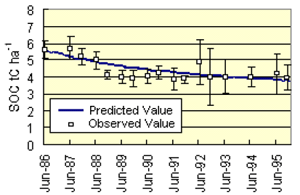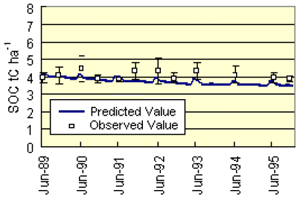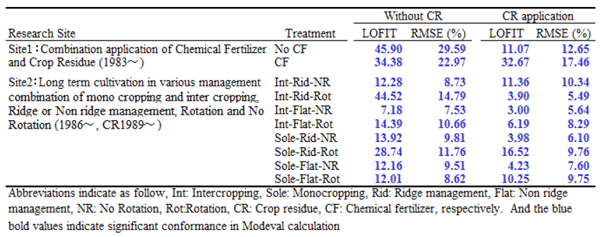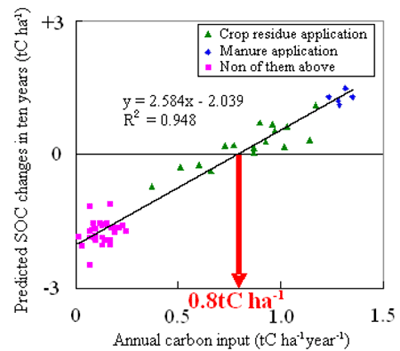Annual carbon requirement for sustainable crop production estimated approximately at 0.8 tC ha-1year-1 in the Sahel, West Africa
Description
Many existing studies have been reported about increasing the crop yield through organic matter application in the Sahel, West Africa. However, they haven’t appeared to have been properly evaluated for their sustainability on crop production, because the evaluations were not based on long-term, but only short-term trials. For the evaluation of sustainability on long-term aspects, the model simulation approach is effective. But most of existing SOM (Soil organic matter) models were constructed for temperate zones. And thus, it is essential to test model applicability before leveraging the model for assessment in the Sahel, which is a tropical semi-arid zone.
Therefore, we validated the applicability of the Rothamsted Carbon Model (Roth-C), which is one of the most widely used and convenient models, through a comparison of predicted and observed SOC changes using long-term experiments that were conducted in the International Crops Research Institute for Semi-Arid Tropics, West and Central Africa (ICRISAT-WCA), Niger.
The SOC changes during the years of observation were shown in Fig. 1 and 2. Conformity between the predicted SOC (Soil organic carbon) values and actual values was shown to be generally good in the observed two types of long-term experiments (total of 32 treatments). The LOFIT (Lack of Fit) and RMSE (Root Mean Square Error) values, the statistical indicators of unconformity in model calculation, did not show significant error between the predicted and observed SOC values (Table 1). It means that Roth-C can successfully estimate the long-term SOC changes in the Sahel, regardless of differences in land management methods as tested in these trials.
Moreover, the annual carbon requirement for maintaining SOC contents in the study area was calculated from simple linear regression analysis between actual annual carbon input and predicted SOC changes after ten years of cultivation, based on 59 treatments (32 from long-term experiment trials, and 27 from technical options suggested by scientists from the JIRCAS project on soil fertility improvement in Niger.). The computed annual carbon requirement was about 0.8tC ha-1 in this region (Figure 3). In addition, the determination coefficient in this regression equation showed as 0.948 which is statistically significant (p < 0.01). Annual input of 0.8tC ha-1 can be converted to 1.6 ~ 2.0t ha-1 as crop residues, and 2.0 ~ 4.0t ha-1 as transferred manures. These values can be filled with crop residues and/or manure applications.
Figure, table
-
Fig. 1. Predicted and observed SOC changes under local practices without crop residue application in Site 2 -
Fig. 2. Predicted and observed SOC changes under local practices with crop residue application in Site 2 -
Table 1. Statistical analysis of conformity between predicted and observed SOC values
-
Fig. 3. Relationship between annual carbon input and predicted SOC changes in ten years
- Affiliation
-
Japan International Research Center for Agricultural Sciences Crop Production and Environment Division
- Classification
-
Administration B
- Term of research
-
FY2008~2009
- Responsible researcher
-
NAKAMURA Satoshi ( Crop Production and Environment Division )
ORCID ID0000-0002-0952-5618KAKEN Researcher No.: 00749921HAYASHI Keiichi ( Crop Production and Environment Division )
OMAE Hide ( Crop Production and Environment Division )
SHINJO Hitoshi ( Kyoto University )
ORCID ID0000-0002-7244-9558KAKEN Researcher No.: 70359826TOBITA Satoshi ( Crop Production and Environment Division )
- ほか
- Publication, etc.
-
Nakamura et al. (2009) 5th conference of the African Soil Science Society November 2009, Cameroon
- Japanese PDF




